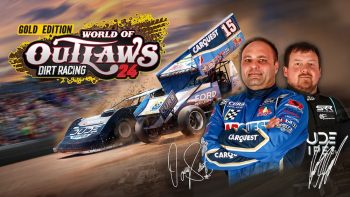
iRacing’s Ongoing Pursuit of Race Simulation Realism
October 6th, 2016 by David Phillips
Thanks to the meticulous work of the simulation industry’s leading artists and vehicle dynamicists, the 50+ digital race cars available on iRacing.com look, drive and race like their real world counterparts. The key word there is “digital.” For, when all is said and done, iRacing’s stock, sports and open wheel cars are constructed of advanced mathematics and physics calculations rather than physical parts. There isn’t a real bolt, A-arm or wing to be found.
So when it comes to modeling its virtual vehicles’ aerodynamic behavior, it’s not as if iRacing can repair to the nearest wind tunnel. Enter TotalSim, a world leader in computational fluid dynamics (CFD) – the use of numerical analysis and algorithms to analyze the interaction of liquids and gases (air, in the case of race cars) on the boundaries of hard surfaces (race car bodies, wings, wheels, etc).
Having partnered with the Ohio-based engineering firm since 2011, iRacing recently renewed its agreement with TotalSim in order to enhance its use of CFD to obtain the most accurate aerodynamic numbers for use in the iRacing vehicle aero model.

When it comes to generating accurate aerodynamic data, CFD is a perfect fit for iRacing’s meticulously modeled cars.
“Our relationship with TotalSim is key to iRacing’s ongoing development of high fidelity simulated race car behavior,” says iRacing vehicle dynamicist Chris Lerch. “With their impressive CFD capabilities, Indianapolis 500- and Formula One-winning designers and engineers, TotalSim ranks among the world’s leading race engineering firms.”
“TotalSim definitely have the know-how in CFD,” says Steve Reis, who joined the iRacing vehicle dynamics program earlier this year. “When I was with Team Penske we worked with TotalSim on our stock car program and enjoyed considerable success.
“TotalSim is key to iRacing’s ongoing development of high fidelity simulated race car behavior.” – Chris Lerch
“Aerodynamic data is very important in simulating a car’s behavior,” Reis continues, “but we rarely get good aerodynamic data from manufacturers and race teams. Because iRacing does such a good job laser scanning and modeling the external geometry of our cars, it sets us up well to use CFD to generate the accurate aerodynamic data we need.”
Unique in the consumer racing game/eSport industry, iRacing’s relationship with the cutting-edge aerodynamics firm typifies its commitment to incorporating state-of-the-art physics in its motorsports simulation service. In particular, iRacing’s vehicle dynamicists are pursuing a broader range of applications than are typically investigated by “conventional” race car aerodynamic testing. Again, CFD is well-suited to iRacing’s needs.

Computational fluid dynamics is crucial to iRacing’s ability to accurately simulate the aerodynamic forces at play in multi-car drafts.
“Think of CFD as a virtual wind tunnel,” says Ray Leto, TotalSim founder and former aerodynamicist and technical director at Rahal Letterman Lanigan Racing. “It enables us to test the physical geometry of iRacing’s cars in a virtual manner, one particularly relevant to sim racing.”
“When people test in a wind tunnel they test in a very specific and limited range of a car’s attitude,” says Lerch. “Our applications cover a much broader range; after all, we want to accurately simulate anything and everything that happens to a race car, not just maximize its performance. For example, we want to understand the aerodynamic forces acting on every car in a four, five or ten car draft, not just what happens when our car drafts another car; we actually care about what a car will do at 90 degree of yaw – totally sideways. That makes CFD a very good option for us: we can test cars in conditions that would be either impossible or impractical to achieve in a physical wind tunnel.”
That last application is particularly significant given iRacing’s plans to feature dirt track racing at Eldora and Williams Grove Speedways by the end of 2016.
“Along with drafting, dirt racing is right at the top of our list in CFD work,” says Lerch. “Dirt track cars operate at high yaw angles that are hard to test in the wind tunnel, making CFD a great fit for us in capturing the aerodynamics of something like a winged dirt sprint car.”

iRacing’s partnership with TotalSim is playing a key role in the development of its digital dirt track cars.
Another important consideration in iRacing’s relationship with TotalSim is the understanding that the partnership is, ultimately, designed to enable iRacing to develop CFD capabilities of its own.
“Ultimately, we’d like to partner with TotalSim in a way that provides sufficient capability and autonomy within the wall of iRacing so we’re not dependent on TotalSim on a day-to-day basis,” says Lerch. “Ray and TotalSim bought into that approach from the start.”
Indeed, the relationship with iRacing is particularly relevant to TotalSim’s efforts to design CFD applications for use by a broad cross section of automotive designers.
“We want to make our knowledge of CFD available to people who can dip in and dip out of aerodynamic testing without making a major investment in wind tunnel programs,” says Leto. “For example, people creating concept cars or after-market body kits. In that sense, iRacing is the perfect test bed. I can even envision a day when iRacers can use CFD as a tool to design their own race cars.”
For now, however, iRacing and TotalSim will continue crunching numbers together on CFD programs designed to expand iRacing’s ability to model the aerodynamic properties of existing race cars and enhance what is already the gold standard in sim racing realism.
Learn about iRacing’s great lineup of race cars, including the Audi R8 and our latest offerings the Nissan GTP ZX-T and the Audi 90 GTO, and take advantage of 40% off special offers here: https://www.iracing.com/

















































